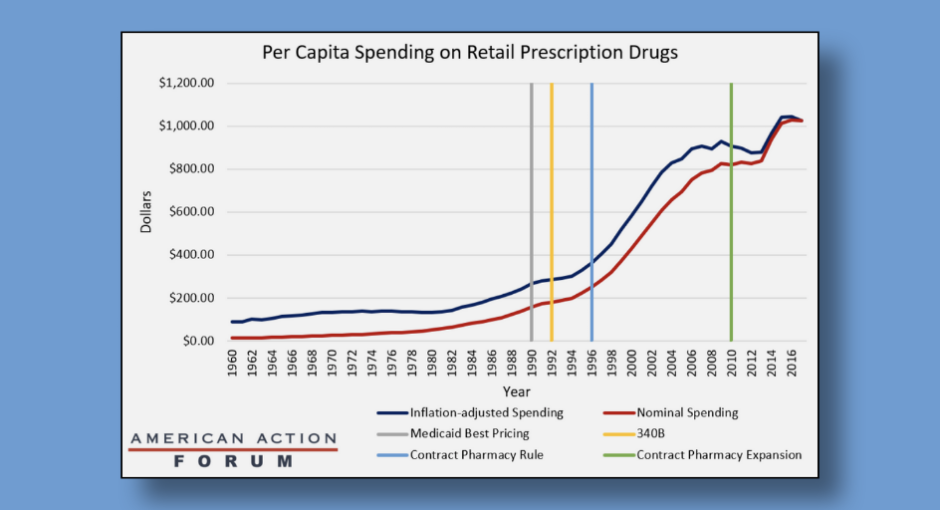An American Action Forum (AAF) data analysis that connects increases in consumer drug spending with the introduction of 340B drug discount and Medicaid drug rebate program policies “is spurious at best,” says an expert on prescription drug costs whose research has found that 340B inflation penalties restrain drug price growth.
AAF, a think tank closely-aligned with the congressional Republican leadership and the pharmaceutical industry, published the analysis online on May 13. It “examines how retail spending per capita on prescription drugs has correlated with the introduction and expansion of the MDRP and 340B program, with specific emphasis on the 340B program,” AAF Health Care Policy Analyst Jackson Hammond wrote.
“There are noticeable, and in some cases significant, increases in the rate of spending following the implementation of these successive policies,” Hammond said. “The Health Resources and Services Administration (HRSA) issued a rule in 1996 allowing hospitals and other entities participating in 340B to use a single contract pharmacy per entity to give 340B-discounted drugs to patients. In 2010, HRSA issued a further regulation allowing 340B entities to use an unlimited number of contract pharmacies. In every case, after a period of adjustment to the newest rule, spending increased further, particularly after the 2010 expansion.”
“While drug pricing is complex, with many factors impacting prices, it is worthwhile to consider whether [the Medicaid drug rebate program] and 340B are having an unintended retail spending impact,” Hammond concluded.
In response to a request for comment on AAF’s analysis, Sean Dickson, Director, Health Policy, at West Health Policy Center, said, “AAF’s attempt to explain drug spending trends by associating periods of drug spending with the MDRP and the 340B program ignores broader market dynamics that have been well-documented in peer-reviewed literature and government reports.”
Drug spending rose at a faster rate from 1996 to 2004 due to “a series of blockbuster drugs in the later ‘90s, while the slowing in 2004 is attributable to increased use of generic drugs and the negotiating power of PBMs following the introduction of the Medicare Part D program in 2006,” Dickson said.
“The spike from 2014 to 2016 is attributable to the introduction of curative hepatitis C treatments,” he said. “The sharp tail in 2016 is attributable to the rapid price declines of these therapies and the fact that most eligible patients who were ready to access treatment had done so in a short period.”
Dickson noted his own research in published in JAMA in 2020 showed that “these price decreases are also likely driven by 340B utilization.” Dickson’s study found that inflation penalties in the 340B program were associated with lower annual drug price increases.
According to a 2019 study by the watchdog group, Project for Government Oversight (POGO), AAF and its political arm American Action Network have received significant funding from the trade group PhRMA.
“According to IRS tax forms examined by POGO,” AHF has received thousands of dollars directly from PhRMA. In 2015, PhRMA gave $130,000 and in 2014 it gave $125,000.”
“According to IRS tax forms, a sister organization, the American Action Network, has received millions of dollars from PhRMA and has also given money to the American Action Forum. In 2016 alone, PhRMA gave over $6 million to American Action Network. Over a 12-month period starting July 2016, American Action Network gave AAF $945,000, the report says.
According to the transparency organization, Open Secrets, American Action Network was the recipient of PhRMA’s largest political contribution in the 2019 election year- a $4.5 million donation. IRS documents for more recent years are not available.


